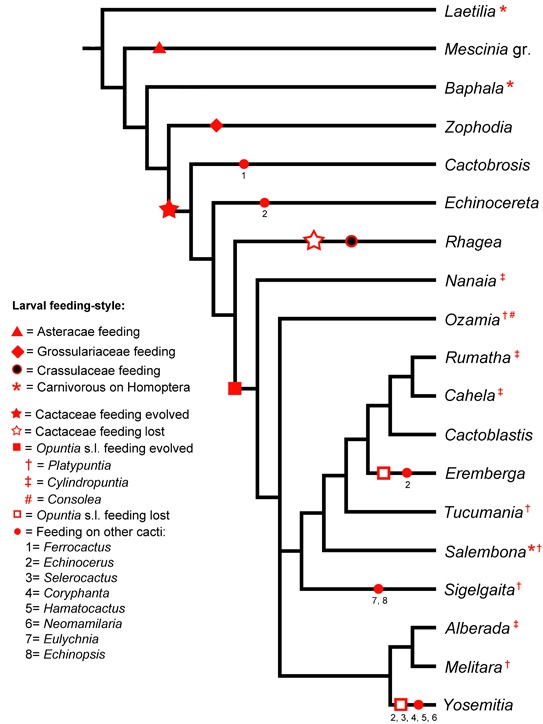Evolution of Host Preferences
Based on the phylogeny presented by Simonsen (2008) the evolution of larval hostplant preferences were analyzed in Mesquite 2.71 (Maddison & Maddison 2009) at the genus level. Host plant data were obtained from Mann (1969), Neunzig (1997), Robinson et al. (2002)
Cactus-feeding evolved once in Pyralidae and subsequently was lost in the genus Rhagea, which switched to feeding on plants in the family Crassulaceae (live-forever). The two basal lineages within the cactus-feeding clade, Cactobrosis and Echinocereta, feed on two genera of barrel-like cacti, Ferrocactus and Echinocerus respectively. However, our analysis indicates that the earliest common ancestor of the remaining cactus-feeders fed on an “Opuntioid” cactus. The genus Opuntia sensu lato recently has been split into several smaller genera (e.g. Hunt et al. 2006, Freeman 2009) of which cactus-feeding phycitines feed on three: Opuntia sensu stricto, Cylindropuntia, and Consolea. When these three genera are treated as ‘Opuntia s.l.’ in the analysis, Opuntia s.l. feeding appears to have had a single origin. Although Opuntia s.l. feeding has been lost independently in the genera Eremberga and Yosemitia, and the species Sigelgaita chilensis, this scenario opens up an intriguing possibility. The clade of moths and the clade of Opuntia s.l. cacti have co-evolved with some becoming restricted to Opuntia s.s. and others evolving with Cylindropuntia and Consolea. Of the three non-Opuntia s.l. feeders in this clade, Eremberga and Sigelgaita chilensis are restricted to a few genera of barrel-like or rod-like cacti (Echinocerus, Echinopsis, and Eulychina) and Yosemitia feeds on several genera of barrel-like cacti (see figure below).
Predacious larvae feeding on scale insects have evolved independently in the non cactus-feeders Laetilia and Baphala, and the cactus-feeder Salembona. Laetilia and Baphala apparently are primarily predacious in all life stages (Neunzig 1997). However, in Salembona the larvae feed on flowers, fruit and shoots of Opuntia s.s. in the spring, but switch to scales on Opuntia later in the year (Mann 1969).
The figure below illustrates the simplified findings of our analysis of the evolution of larval host preferences.

References
Hunt, D., Taylor N, Charles, G. (2006): The New Cactus Lexicon, Volumes I and II. 900 pp. DH Books.
Maddison WP, Maddison DR. 2009. Mesquite: a modular system for evolutionary analysis. Version 2.71. http://mesquiteproject.org.
Freeman, D. 2009. Cactiguide. http://cactiguide.com/. Accessed December, 2009.

